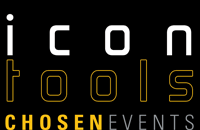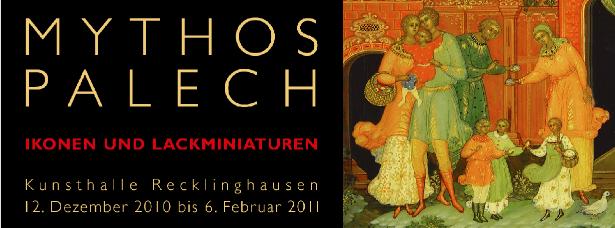
Exhibition, Recklinghausen, Germany
The Myth of Palekh – Icons and Lacquer Miniatures
Wednesday 17 November 2010, by Icon Network

|
[
The Myth of Palekh – Icons and Lacquer Miniatures
Exhibition at the Kunsthalle Recklinghausen
December 12th 2010 – February 6th 2011
The Recklinghausen Icon Museum, opened in 1956, is the most important museum of Eastern church art outside the Orthodox countries. Well over a thousand icons, gold embroideries, miniatures and works in wood and metal from Russia, Greece and the Balkan countries give a comprehensive survey of the manifold subjects and the stylistic development of icon painting and applied art in the Christian East.
The town of Recklinghausen lies in the Ruhr District and is therefore part of the ‘European Capital of Culture Ruhr.2010’. As a special project of the town on this occasion, the Icon Museum is planning an exhibition. The painters’ village of Palekh, situated three hundred kilo- metres to the north-east of Moscow, is the centre of the exhibition. Art lovers associate two special types of Russian art with the name of Palekh: exclusive, exquisite- ly detailed painted icons and the equally delicately exe- cuted lacquer miniatures on papier-mâché.
The village of Palekh has been a centre of icon painting since the 17th century. Influenced by the tradition of the Stroganov Style and the fresco and icon painting in the towns of the upper Volga area, the best artists of Palekh developed the style known today as the ‘Palekh Style’. Typical attributes of the Palekh Style: In addition to the saints depicted on them, these Palekh icons also feature miniature architectural backdrops, delicately painted in pastel colours and richly decorated with white ornaments, as well as lush landscapes, as equally important elements of the composition. The painted area is often subdivided into a multitude of single little pictures where e.g the Feasts of the Christian Orthodox Liturgical Year or saints with their hagiographical scenes are shown in filigreed painting.
The 1917 October Revolution resulted in a massive decline in demand for icons, and the Palekh painters found their livelihoods threatened. In the early 1920s, some Palekh icon painters began to try their hands at lacquer painting. In 1924, they founded the ‘Palekh Artel of Ancient Painting’ and began commercial production of small objets d’art on papier-mâché, painted and lacquered using the egg tempera technique and gold. The artists, with their roots firmly anchored in the old tradition of icon painting, had thus found a way to go on putting their artistic skills in fine art painting to good use under changed social conditions. Everyday rural scenes and scenes from Russian fairy tales, from old Russian heroic epics and from Russian history were the principal subjects depicted on the lacquer works. In the 1930s, the artists also began to paint themes based on political ideology. These depictions glamorised the social changes attributed to the October Revolution, and the glory of the Red Army in the civil war and later in the Second World War. The result was a symbiosis between the socialist realism promoted by the political system and stylistic elements from icon painting.
Since the 1990s, icon painting has started up again in Palekh. Thus the circle is completed: from icon to lacquer miniature and back to the icon.
The exhibition tries to duplicate this change. It will present icons, many of them from the rich collection of the Recklinghausen Icon Museum, from the ‘Collezione Intesa Sanpaolo, Vicenza, Gallerie di Palazzo Leoni Montanari’, but also from private collections.
Furthermore there will be shown magnificent examples of lacquer miniatures from large collections in Switzerland and The Netherlands; and last but not least icons painted in the last two decades.
The exhibition is meant for both specialists and a wider public, as the delicately painted icons and lacquer miniatures are a delight for the eye of every art lover! A detailed catalogue with scientific contributions will be published to accompany the exhibition.
A meeting dedicated to the same topic will take place on January 22nd at the Festspielhaus in Recklinghausen. In autumn a detailed program will be placed on the Museum’s homepage. Upon request, it can also be mailed.
The curators of the exhibition: Dr. Eva Haustein-Bartsch, director of the Recklinghausen Icon Museum Dr. Felix Waechter, Switzerland The exhibition is staged in cooperation with the Münster Museum for Lacquer Art, which will present an exhibition ‘The School of Palekh (1924 – 1950)’ from October 17th 2010 – February 13th 2011.
Address: Kunsthalle Recklinghausen Große-Perdekamp-Straße 25–27 (opposite the Central Station) D-45657 Recklinghausen Opening hours: Monday – Sunday 11–18 h, Wednesday 11–20 h
Informations: Ikonen-Museum Tel. 0049-2361-501041 Fax 0049-2361-501942 E-mail: ikonen@kunst-re.de